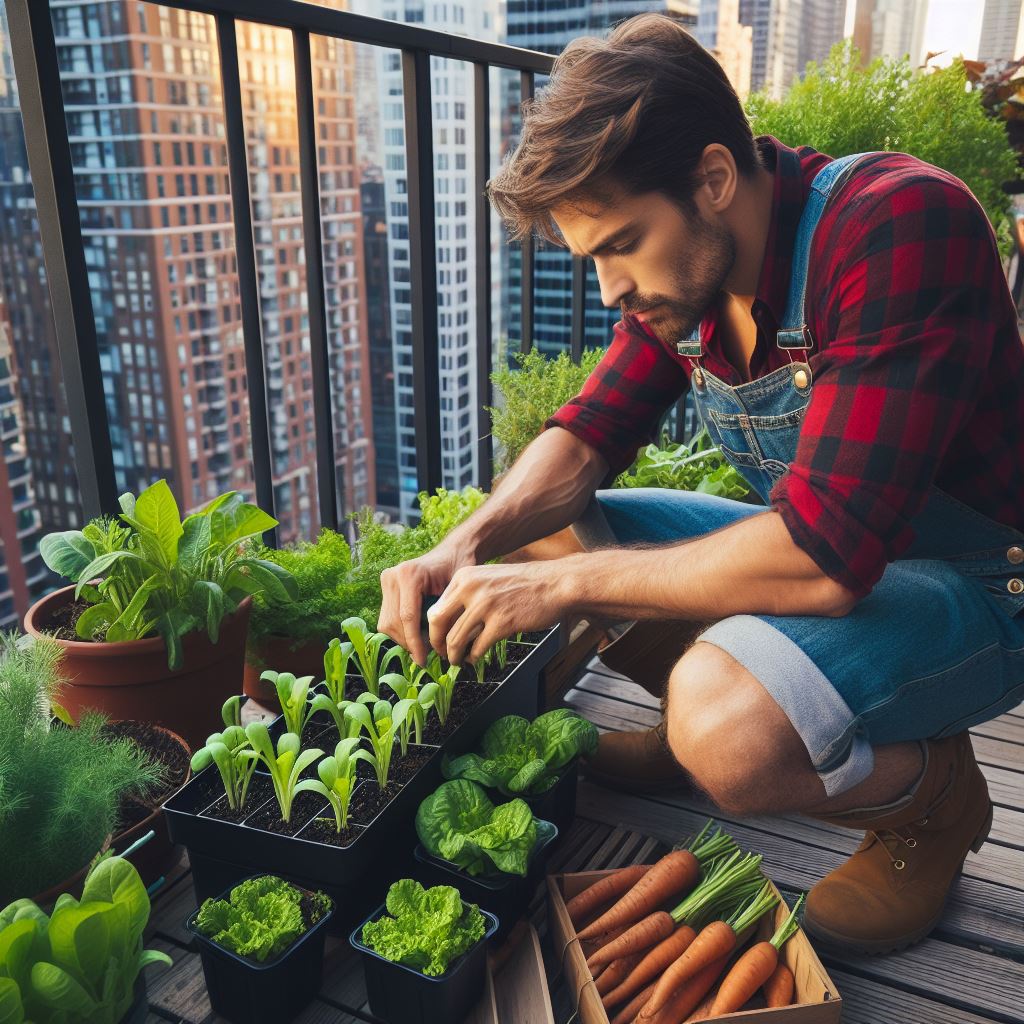Introduction
Brief explanation of window farms
Window farms are small-scale hydroponic systems that allow urban dwellers to grow produce indoors.
Plants are stacked vertically on a window using recycled containers and basic materials.
Nutrient-rich water circulates via pumps on timers.
Sunlight streams in, requiring no artificial lights.
Importance of small-scale farming revolution
Window farming is part of a growing movement toward small-scale food production in cities.
More urbanites want to grow their own produce, even without yards.
Technologies like window farms empower beginners to cultivate greens on windowsills.
People are reimagining how to access fresh food in space-constrained settings.
Purpose of the blog post
This blog post shares the vision and practicalities behind the window farming revolution.
We’ll explore the benefits of window farms for urban growers and the environment.
You’ll learn the basics of how window farms work, materials needed and maintenance.
We’ll provide tips and tutorials for designing your own system.
Window farms allow anyone to become a small-scale farmer.
Join us as we delve into this accessible, sustainable way to bring food production into cities.
What are window farms?
Definition and concept of window farms
Window farms are small-scale agricultural systems that allow individuals to grow plants vertically in their windows.
Transform Your Agribusiness
Unlock your farm's potential with expert advice tailored to your needs. Get actionable steps that drive real results.
Get StartedComponents of a window farm system
- A window farm typically consists of multiple stacked rows of plant containers.
- Each container is connected to a water reservoir through a network of tubes.
- An air pump is used to oxygenate the water and provide nutrients to the plants.
Environmental benefits
- Window farms can reduce the carbon footprint associated with food transportation.
- They promote local and sustainable agriculture, reducing the need for pesticides and herbicides.
- Window farms also conserve water by recirculating it within the system.
Health benefits
- Growing and consuming fresh produce from window farms can improve nutrition and overall health.
- Window farms provide access to organic and pesticide-free vegetables and herbs.
- Indoor plants in window farms can improve air quality by removing toxins and releasing oxygen.
Economic benefits
- Window farms can save money on groceries by producing fresh produce at home.
- They can also generate a potential income stream through selling excess produce or plant starts.
- With proper maintenance, window farms have a long lifespan, providing long-term economic benefits.
In essence, window farms offer a unique and innovative solution for urban agriculture.
By utilizing vertical space in windows, individuals can grow their own food, experience numerous benefits, and contribute to a more sustainable future.
How to set up a window farm
A window farm is a simple and efficient way to grow your own fresh produce right in your own home.
With just a few materials and some basic steps, you can set up your own window farm and enjoy the benefits of homegrown vegetables and herbs.
Materials needed
- Plastic bottles or containers
- Fishing line or strong string
- Net pots or cups
- Growing medium like perlite or coconut coir
- Nutrient solution for hydroponics
- Seeds or seedlings of your choice
Step-by-step instructions for assembly
- Choosing the right location: Select a window that receives ample sunlight throughout the day for optimal plant growth.
- Determining the number of plants: Decide the number of plants you want to grow based on the available space and your needs.
- Creating the hydroponic system: Attach fishing lines or strings to the containers and secure them to create a vertical garden system.
- Installing the plants: Place net pots or cups filled with growing medium into the containers and sow the seeds or transplant seedlings.
- Maintaining the window farm: Regularly monitor the water levels and nutrient solution in the containers, ensuring proper hydration for the plants.
Check for pests or diseases and take necessary actions to protect your plants.
Trim and harvest your crops as they grow, ensuring adequate airflow for healthier plants.
Setting up a window farm allows you to have fresh produce right at your fingertips.
Not only does it provide you with a sustainable source of food, but it also enhances the aesthetics of your home with lush greenery.
Get started on your window farm today and embark on a journey towards self-sufficiency and environmental consciousness.
Read: Mobile Markets: Bringing Farms to Cities
Best plants for window farming
Herbs and spices
- Basil: This aromatic herb thrives in a window farm, providing fresh leaves for culinary delights.
- Mint: Known for its refreshing flavor, mint is easy to grow and adds a touch of green to your window.
- Rosemary: With its distinctive fragrance, rosemary is a popular choice for window farmers who love to cook.
- Thyme: This versatile herb adds depth of flavor to dishes and requires minimal maintenance.
Leafy vegetables
- Lettuce: Perfect for window farming, lettuce varieties like romaine and butterhead are rich in nutrients.
- Spinach: Packed with iron and vitamins, spinach is an excellent choice for a compact window farm.
- Kale: Highly nutritious and resilient, kale can be harvested throughout the growing season.
- Swiss chard: With its colorful stems and glossy leaves, Swiss chard is both visually appealing and nutritious.
Small fruits and berries
- Strawberries: These sweet and juicy fruits can be easily grown in compact vertical window farms.
- Tomatoes: Choose compact varieties like cherry or patio tomatoes that thrive in containers.
- Blueberries: Ideal for window farming, blueberry plants add a touch of beauty while yielding tasty fruits.
- Raspberries: These delicate berries can be successfully grown if provided with proper support and care.
Flowers and ornamental plants
- Pansies: These cheerful, colorful flowers thrive in window farms and bring a touch of joy to any space.
- Miniature roses: Compact and fragrant, miniature roses are a favorite choice for indoor gardening.
- Geraniums: With their vibrant blooms and easy maintenance, geraniums are a great addition to window farms.
- Marigolds: These sunny flowers act as natural pest repellents, promoting a healthy window farm ecosystem.
Window farming allows urban dwellers to enjoy the benefits of gardening within limited space.
Selecting the right plants
By selecting the right plants, you can create a thriving mini garden that not only adds beauty to your living space but also provides fresh herbs, vegetables, fruits, and flowers.
When it comes to herbs and spices, basil, mint, rosemary, and thyme are all excellent choices.
Their enticing aromas and flavors enhance your culinary experiences while adding greenery to your window.
Leafy vegetables like lettuce, spinach, kale, and Swiss chard can be easily grown and harvested on a continuous basis.
These nutrient-rich plants offer fresh and healthy ingredients for your meals throughout the year.
For those with a sweet tooth, small fruits and berries like strawberries, tomatoes, blueberries, and raspberries can be grown in compact vertical window farms.
The joy of plucking these delicious treats straight from your window is unmatched.
In addition to edible plants, you can also incorporate flowers and ornamental plants into your window farm.
Pansies, miniature roses, geraniums, and marigolds add beauty and color to your living space while contributing to a healthier ecosystem by attracting beneficial insects.
Remember, successful window farming requires regular watering, adequate sunlight, and appropriate plant care.
With these considerations in mind, you can turn your window into a small-scale revolution by cultivating a diverse range of plants.
Unlock the potential of your window farm and immerse yourself in the joy of homegrown goodness.
Read: The Urban Farmer’s Guide to Success
Showcase Your Farming Business
Publish your professional farming services profile on our blog for a one-time fee of $200 and reach a dedicated audience of farmers and agribusiness owners.
Publish Your Profile
Tips for Successful Window Farming
One of the reasons why window farming has gained popularity is its ability to provide fresh produce in small spaces.
However, like any form of gardening, it requires proper care and attention to ensure successful growth.
Here are some essential tips for achieving thriving window farms:
Monitoring and Maintaining Water Levels
- Check water levels frequently to ensure plants receive adequate hydration.
- Use a self-watering system or install a drip irrigation system to automate watering.
- Adjust water levels depending on the stage of plant growth and environmental factors.
- Avoid waterlogging by providing proper drainage to prevent root rot.
Providing Adequate Lighting
- Place the window farm in a location that receives maximum sunlight, preferably south-facing windows.
- If natural lighting is insufficient, use artificial grow lights, such as fluorescent or LED bulbs.
- Position grows lights at an appropriate distance from plants to avoid burning or shading them.
- Ensure plants receive an average of 6 to 8 hours of light per day for optimal growth.
Choosing Appropriate Plant Varieties
- Select plants that are suitable for indoor growth and compact spaces.
- Herbs like basil, mint, and parsley, as well as salad greens, are great choices for window farming.
- Consider dwarf or compact varieties of vegetables for better yield in limited space.
- Read seed packets or consult gardening resources to choose plants that thrive in your climate.
Pest Management in Window Farms
- Inspect plants regularly for signs of pests or diseases such as yellowing leaves or webbing.
- Introduce beneficial insects like ladybugs or lacewings to control pests naturally.
- Use organic pest control methods such as neem oil, insecticidal soaps, or homemade sprays.
- Keep the window area clean and free from debris to avoid attracting pests.
Successful window farming requires consistent monitoring, adequate lighting, appropriate plant selection, and effective pest management.
By following these tips, you can create a thriving window farm that supplies you with fresh, homegrown produce year-round.
Read: Urban Farming: Boosting Food Security
Find Out More: Edible Schoolyards: Kids in Urban Farming
Success stories and testimonials
Sharing experiences of window farm users
- Window farming has brought a revolution in urban gardening, as shared by many enthusiastic users.
- Sara, a window farm user from New York, emphasizes how it transformed her apartment into a green oasis.
- Mark, a beginner window farmer, explains how easy it was to start and grow his own fresh herbs.
- Lisa, a busy professional, expresses how window farming allows her to have access to healthy produce without much effort.
- The experiences and stories of window farm users serve as inspiration and motivation for others to start their own.
Testimonials showcasing the benefits and advantages
- Michael, a window farm user, emphasizes how it helps in reducing his grocery bill by growing his own vegetables.
- Jenny, a health-conscious individual, shares how window farming ensures she consumes pesticide-free and organic produce.
- John, a climate advocate, highlights the environmental benefits of window farming, such as reduced carbon footprint.
- The testimonials illustrate how window farming improves food security and sustainability at the individual level.
Tips and insights from experienced window farmers
- Laura, an experienced window farmer, suggests starting with low-maintenance plants like herbs for beginners.
- Tom, a seasoned window farm enthusiast, advises experimenting with different plant varieties to find what grows best.
- Iris, a successful window farmer, recommends using a timer for automated watering to avoid over or under-watering.
- These tips and insights from experienced farmers are invaluable for those starting their window farming journey.
Window farming has not only revolutionized urban gardening but also showcased numerous success stories and testimonials.
The experiences of window farm users not only inspire others but also highlight the significant benefits and advantages.
Testimonials emphasize the reduced grocery bills, access to organic produce, and positive environmental impact.
Additionally, the tips and insights from experienced window farmers provide practical guidance for beginners.
With such success stories and useful guidance, anyone can embark on their window farming journey and enjoy the benefits of homegrown, fresh produce.
Read: Vertical Farming: Scaling New Heights
Window farms in urban environments
Overcoming space limitations
In densely populated urban areas, finding space for traditional gardens can be challenging.
Window farms offer a solution by utilizing vertical space and making use of windows for sunlight.
The vertical structure allows multiple layers of plants, maximizing the space available for cultivation.
With window farms, even individuals living in small apartments can grow their own herbs and vegetables.
Community impact and involvement
Window farms have the potential to promote community engagement and collaboration.
They can serve as a conversation starter, bringing neighbors together and fostering a sense of belonging.
Community members can share tips, resources, and even plants, creating a supportive network of urban gardeners.
Window farms also contribute to the beautification of urban areas, making them more inviting and vibrant.
Contribution to local food production
Window farms have the potential to play a role in increasing local food production.
By growing food indoors, urban dwellers reduce their dependence on food transported from far distances.
This reduces carbon emissions associated with transportation and supports a more sustainable food system.
The availability of fresh produce grown locally also promotes healthier eating habits in urban communities.
Furthermore, window farms can contribute to food security by providing access to fresh, nutritious food year-round.
In a nutshell, window farms offer a small-scale revolution for urban environments.
By overcoming space limitations, they allow individuals to become active participants in food production.
Through community impact and involvement, a sense of togetherness and shared knowledge is fostered.
And with their contribution to local food production, window farms promote sustainability and food security.
Embracing this innovative approach to urban gardening can lead to a more resilient and healthier future.
Conclusion
Window farms offer an accessible way to grow food in urban settings.
Compact and self-contained, they allow fresh produce on even the smallest budgets and spaces.
Anyone can assemble a low-cost system with basic materials.
Window farms require little maintenance while yielding nutritious herbs and veggies.
More city dwellers are embracing small-scale farming.
Window farms exemplify this hands-on food revolution.
They empower beginners to cultivate greens on windowsills.
We can spread this movement by sharing window farm tips and techniques.
Readers, join in! Build your own window farm, no yard required.
Showcase Your Farming Business
Publish your professional farming services profile on our blog for a one-time fee of $200 and reach a dedicated audience of farmers and agribusiness owners.
Publish Your ProfileStart small with a few containers or expand over time.
Customize with your favorite herbs and salad greens.
Swap ideas in online forums and show off your harvests.
Take the next step in becoming an urban farmer.
Let your window farm nourish you while lightening your ecological footprint.
Together, our collective efforts can reshape how cities are fed.
The window farming community welcomes you – let’s grow together!




